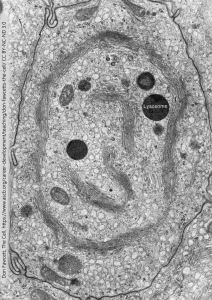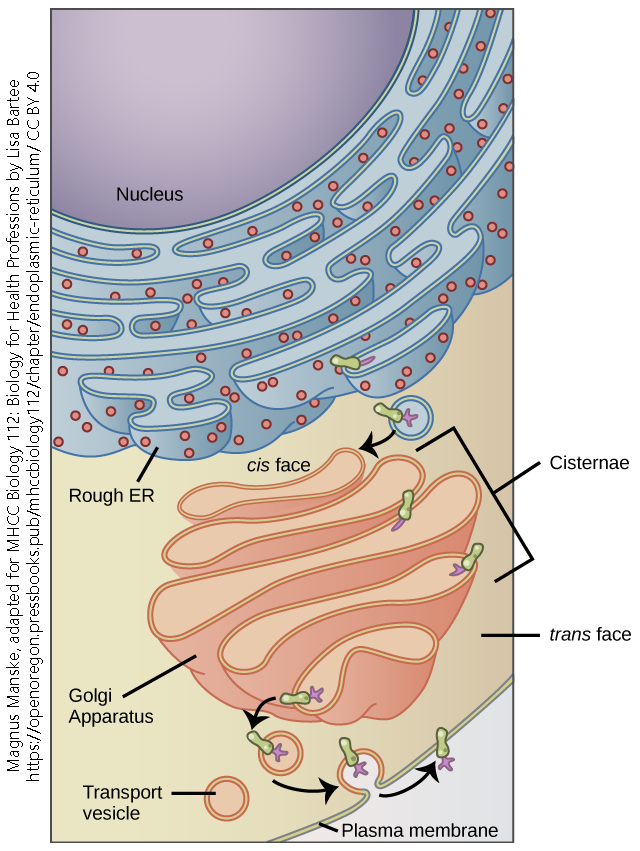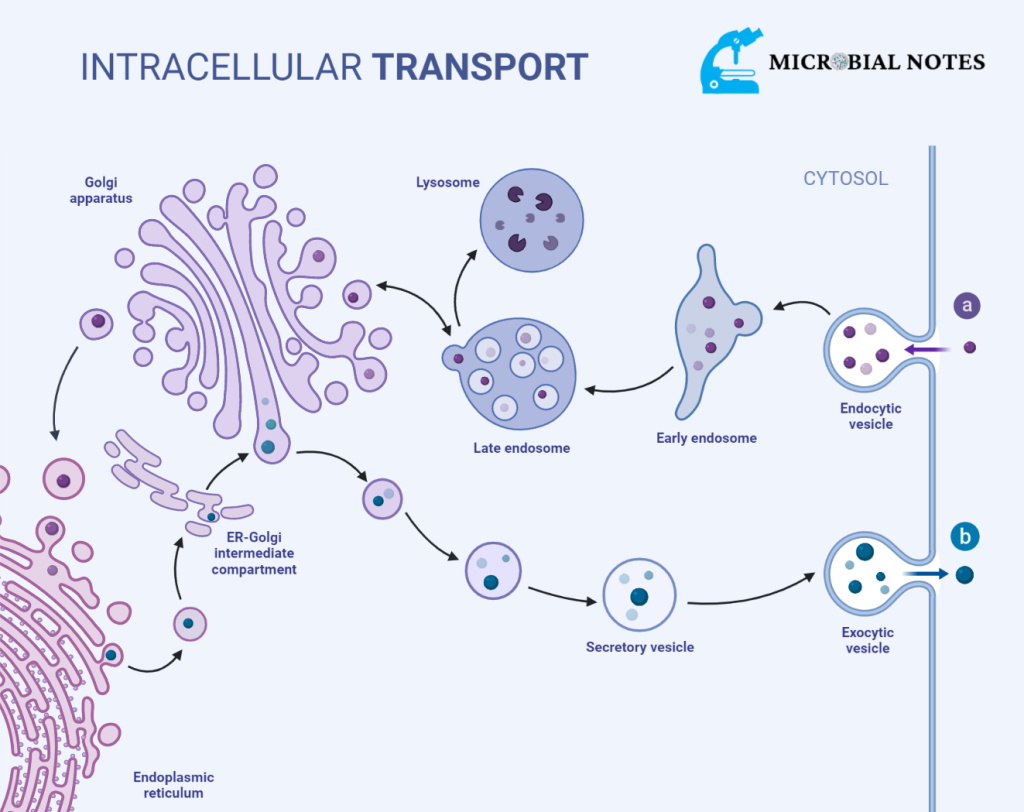The Golgi Complex in Neurons
Avery Hamilton and Jim Hutchins
Chapter under construction. This is the first draft. If you have questions, or want to help in the writing or editing process, please contact hutchins.jim@gmail.com.
Introduction
If you were examining the secretory pathway through a microscopic lens, the structure of the Golgi complex is easily distinguished by its multiple flat stacked membrane (cisternae). The Golgi apparatus would be considered our cellular Amazon or FedEx. This membrane-bound organelle is a cell’s packaging and distribution center. The Golgi apparatus has a long controversial history dating back to 1898 where it was discovered by Camilo Golgi. It was fiercely debated within the scientific community, many calling the structure a deposit of metallic particles on diverse cytoplasmic structures rather than a genuine new cell constituent (Bentivoglio M, 1998, p. 1).

The Secretory Pathway
To understand the complexities of the Golgi apparatus it’s imperative that you have a brief understanding of the secretory pathway. It is likely, this is not the first time you have been familiarized with this material. So, we will not go in depth about the other components of the secretory pathway. Rather for additional information you can visit previous chapters covering the endoplasmic reticulum (ER).
The secretory pathway begins with the endoplasmic reticulum where protein synthesis occurs. Proteins and lipids undergo folding and modifications that break down larger molecules for the intention of sending them through vesicle transport to the Golgi apparatus. Here our story begins.
 Structure of the Golgi Apparatus
Structure of the Golgi Apparatus
To start, the Golgi apparatus appears as flat, disk shaped pouches called “cisternae.” In most cells, there are approximately 4-8 cisternae in the Golgi body. However, in some cases there have been up to 30 in single celled organisms (Bentivoglio M, 1998, p. 1). These membrane stacks are held together by matrix proteins that act as a sort of glue.
The Golgi matrix is composed of varying proteins that help assist the apparatus with rapid disassembly/reassembly throughout cell cycle progression (Xiang & Wang, 2011). The Golgi matrix, with aid of cytoplasmic microtubules, suggests that these structures are essential for the Golgi to maintain its structure and function. However, the Golgi body consists of several distinct parts:
-
Cis-Golgi Network
The cis face is the cisternae that is adjacent to the endoplasmic reticulum’s exit sites. A terminal for where proteins and lipids arrive from the endoplasmic reticulum with the help from the endoplasmic reticulum-Golgi intermediate compartment (ERGIC). Here vesicles fuse with the Golgi and processing can begin.
-
Medial Cisternae
https://app.biorender.com/biorender-templates/figures/all/t-60958b92c2d4dd00a587f0f6-protein-post-translational-modifications
This body of cisternae are the stacks that are between the forming face (cis face) and the leaving face (trans face). In the medial region is where the bulk of post-translational modifications occur. Which is when chemical groupings are added to proteins for chemical alterations (Hutchins et al., n.d.). Some chemical grouping examples may be:
- sugar groups (glycosylation)
- acetyl groups (acetylation)
- phosphate groups (phosphorylation)
- methyl groups (methylation)
- sulfate groups (sulfation)
- small ubiquitin-related modifier (SUMO) groups (SUMOylation)
- farnesyl groups (farnesylation)
- geranylgeranyl groups (geranylgeranylation)
Essentially, as proteins and lipids move from one cisternae or network to another they come into contact with enzymes that help create newly-formed polypeptides.
-
Trans-Golgi Network
The trans face is the cisternae that faces the plasma membrane. Moreover, this is where newly modified proteins and lipids get sorted into their respective vesicles to be distributed to their intended destination. The trans face is like a mail room that is sorting mail for transport.
-
Vesicles
For the Golgi apparatus to complete its designated service to a cells function it uses vesicles that act as little cars going to and from places to transport proteins and lipids. Therefore, vesicles can be further divided into groups based on their jobs:
- Coated Vesicles : Are responsible for material transport between the endoplasmic reticulum, Golgi, and additional part of the cell.
- Transport Vesicles: Tasked with moving between the cisternae within the Golgi complex.
- Secretory Vesicle: How proteins are transported for secretion out of the cell (exocytosis).
Now that we have taken a closer look at the different parts that make up the Golgi apparatus let’s put this organelle into action.
Function
Above is an attached short video that eloquently demonstrates the Golgi complex at work. Take a moment to watch for a recap and to see what we have learned thus far in action.
As demonstrated we understand that the purpose of the Golgi apparatus is to modify, package and transport proteins and lipids. This is achieved through complex chemical alterations and vesicles transport. Newly-formed polypeptides are then sent out of the Golgi complex in one of three ways. (1) To be sent to lysosomes where they will fuse. (2) Into the cytoplasm to be recycled. (3) To be secreted from the cell in a process known as exocytosis.

The Cisternal Maturation Model
Today there are still no definitive answers for how proteins and lipids move from the forming face to the leaving face of the Golgi apparatus. We know that vesicles are responsible for moving cargo, but the mechanism responsible is still unclear. Many researchers have gravitated to what they call the cisternal maturation model. Which suggests that cisternae mature and then move throughout the Golgi starting from the cis face and proceeding to the trans face. Meaning, that the cisternae themselves are not stationary (Luini, 2011). What do you think? Do you align with the current perspective of how proteins move across this membrane-bound organelle? If not, the great thing about science is that it is always evolving!
Conclusion
We have explored the incredible system or assembly line that makes up the Golgi apparatus. This may not have been the most comprehensive explanation for how the golgi body executes its cellular tasks, but I hope that it provided a foundation of knowledge for the Golgi complex.
Key Terms
Cisternae: Flattened membrane or sac that makes up the Golgi complex.
Cytoplasm: Jelly-like fluid that fills the interior of a cell.
Endoplasmic Reticulum: An organelle that is involved in protein synthesis, calcium storage and lipid metabolism.
Enzyme: Biological catalysts that speed up chemical reactions.
Exocytosis: Process by which cells excrete waste to the cells exterior.
Lysosome: Membrane-bound organelle that has digestive enzymes.
Organelle: Subcellular structure that performs a specific function in a cell.
Vesicle: Small cellular containers that transport materials within a cell.
Media Attributions
- Golgi complex © Don W. Fawcett is licensed under a CC BY-NC-ND (Attribution NonCommercial NoDerivatives) license
- Endomembrane system © Betts, J. Gordon; Young, Kelly A.; Wise, James A.; Johnson, Eddie; Poe, Brandon; Kruse, Dean H. Korol, Oksana; Johnson, Jody E.; Womble, Mark & DeSaix, Peter is licensed under a CC BY (Attribution) license
- IMG_5188 is licensed under a All Rights Reserved license

